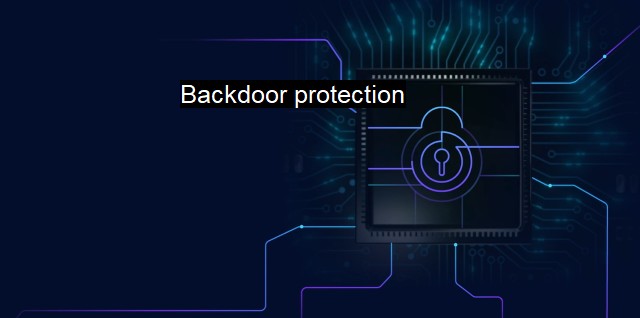What is Backdoor protection?
The Importance of Backdoor Protection in Cybersecurity: Keeping Your Systems Safe from Trojan Viruses and Hackers
Backdoor protection refers to a critical component in the realm of cybersecurity and antivirus software, specifically aiming to guard systems against illegal access or unauthorized intrusion. In cybersecurity parlance, a backdoor is a method, often secret, of bypassing normal authentication or encryption in a computer, a product, or an embedded device, etc. Cybercriminals exploit these backdoors to press unauthorized and illicit access into strategic networks or personal computer systems, often for malicious outcomes.One way of perceiving backdoor protection is by equating it to monitoring the hidden or 'backdoor' entries into a house. Say suppose, a person can attempt to break into a house either by force or by sneaking into an unlocked or unmonitored, backdoor. Similarly, in the virtual world, while security measures increasingly strengthen against harmful software and potential invasions, cybercriminals persistently develop alternative routes to bypass these robust mechanisms.
Backdoor attacks are one such alternative where cybercriminals bypass regular security protocols to stealthily infiltrate systems. These concealed, difficult-to-trace attacks can result in personal data theft, widespread disruption systems, or even launching of distributed denial-of-service (DDoS) attacks on extensive networks.
Histories and stories of cyber threats illustrate how exploiting backdoors often leads to significant problems. For instance, the notorious worm "Conficker" was used to form a botnet, which was responsible for the creation of more than a million backdoors on strategic systems worldwide. These instances highlight the critical importance of backdoor protection.
Backdoor protection guards against these secret infiltrations through insignificant or overlooked loopholes. It employs various protective features like sophisticated monitoring systems to report unusual activities, advanced encryption to block bypasses, and quarantine measures for controlling potentially infected sections.
In a more detailed aspect, many antivirus software companies have focused on algorithmic solutions for backdoor protection. Incorporating AI can potentially discover innovative attack patterns and proactively develop defense mechanisms for these. Constant updates and patches can help keep these AI-equipped systems ahead or inline of the ever-advancing scammer strategies.
Generally, backdoor protection is both a proactive and reactive strategy. Proactive backdoor protection involves non-disclosure of private and confidential digital content, using encrypted connections, sufficient personal cyber hygiene, and employing powerful antivirus software. A small part of backdoor protection is reactive, dealing with resolving a crisis once it has occurred.
Backdoor protection doesn't always entirely revolve around complex software solutions. Simple, healthy practices such as regularly changing passwords, not clicking on suspicious links or mails, and not downloading from untrusted sources contribute vastly towards maintaining a safe digital space.
Backdoor protection is a multipart approach to cybersecurity. It is not just about securing a network or systems but about creating a cyber environment that can efficiently recognize, prevent, and care for any potential and actual backdoor exploitations. Despite mounting cyber threats, appropriate backdoor protection can provide an additional safety layer and lend substantial control over personal information in our vastly advancing digital age. It should certainly be an indispensable part of everyone's digital checklist, to protect personal and vital data from cyberattacks.
Rightly headed, the future appears promising in providing adequate backdoor protection. With technology expanding its horizons, measures such as blockchain technology and advanced encryption algorithms like RSA or AES are being employed to provide a secure barrier towards any unauthorized access.
Evidently, backdoor protection is a steadfast requirement in the current evolving cybersecurity landscape, and increasing awareness about the same is a necessity for secure cyber world. Backdoor threats are constantly evolving, and so must cybersecurity measures to ensure effective backdoor protection and free the cyber universe from such malicious sneak attacks.

Backdoor protection FAQs
What is backdoor protection in cybersecurity?
Backdoor protection is a security measure used to prevent unauthorized access to a computer or network system through a backdoor or hidden entry point. It involves implementing software and hardware solutions to detect and block any attempt to exploit vulnerabilities that hackers may use to gain access to a system.How does backdoor protection work?
Backdoor protection works by implementing various security measures, such as firewalls, intrusion detection systems, and anti-virus software, that monitor and block any suspicious activity on a system. These measures are designed to prevent hackers from gaining unauthorized access to a system through a backdoor or other hidden entry points.Why do I need backdoor protection?
Backdoor protection is essential to protect your computer or network system from potential cyber attacks. Without it, hackers can gain unauthorized access to your system and steal sensitive information, install malware or ransomware, and cause other types of damage. By implementing backdoor protection, you can ensure the security and integrity of your system, preventing any breach of data and loss of revenue or reputation.What are some best practices for implementing backdoor protection?
To implement effective backdoor protection, you should regularly update your security software, implement strong passwords, enable two-factor authentication, regularly backup your data, and train your employees on cybersecurity best practices. Additionally, you should perform regular security audits and vulnerability assessments to identify and address any potential weaknesses in your system.| | A | | | B | | | C | | | D | | | E | | | F | | | G | | | H | | | I | | | J | | | K | | | L | | | M | |
| | N | | | O | | | P | | | Q | | | R | | | S | | | T | | | U | | | V | | | W | | | X | | | Y | | | Z | |
| | 1 | | | 2 | | | 3 | | | 4 | | | 7 | | | 8 | | |||||||